Abstract
A graph G admits an H-covering if every edge of G belongs to a subgraph isomorphic to a given graph H. G is said to be H-magic if there exists a bijection such that is a constant, for every subgraph isomorphic to H. In particular, G is said to be H-supermagic if . When H is isomorphic to a complete graph , an H-(super)magic labeling is an edge-(super)magic labeling. Suppose that G admits an F-covering and H-covering for two given graphs F and H. We define G to be -sim-(super)magic if there exists a bijection that is simultaneously F-(super)magic and H-(super)magic. In this paper, we consider -sim-(super)magic where H is isomorphic to three classes of graphs with varied symmetry: a cycle which is symmetric (both vertex-transitive and edge-transitive), a star which is edge-transitive but not vertex-transitive, and a path which is neither vertex-transitive nor edge-transitive. We discover forbidden subgraphs for the existence of -sim-(super)magic graphs and classify classes of -sim-(super)magic graphs. We also derive sufficient conditions for edge-(super)magic graphs to be -sim-(super)magic and utilize such conditions to characterize some -sim-(super)magic graphs.
1. Introduction
In this paper, all graphs to be considered are finite, simple, and undirected. We write to define the set of consecutive integers , for any positive integers . We denote two isomorphic graphs G and H with . The degree of vertex x of G, denoted by , is the number of vertices in G adjacent to x.
Let G be a graph with the vertex set and the edge set . An edge-magic total labeling (or EMT labeling for short) of a graph G is a bijection with the property that there exists a constant k such that , for any edge . Then, G is said to be edge-magic (EMT) and k is called a magic sum. This notion was defined by Kotzig and Rosa [1], who called it magic valuation, and later rediscovered by Ringel and Lladó [2]. In [2], Ringel and Lladó conjectured that all trees are EMT. Since then, numerous papers associated with EMT labeling have been published.
In 1998, Enomoto et al. [3] introduced a special case of EMT labeling with the extra property that . It is called a super edge-magic total labeling (SEMT labeling). A graph G that admits an SEMT labeling is said to be super edge-magic (SEMT). An SEMT labeling has a significant role in graph labeling because it is related to other types of labelings. Figueroa-Centeno et al. [4] found relationships between SEMT and well-known labelings such as harmonious, sequential, and cordial labelings. Bača et al. [5] established the relationship between SEMT and EMT labelings and -edge-antimagic vertex labeling. Other relationships and comprehensive surveys about SEMT and EMT graphs can be found in [6,7,8,9].
The next Lemma states a necessary and sufficient condition of an SEMT graph. We frequently use this condition to construct SEMT labelings of some graphs.
Lemma 1
([4]).A graph G is SEMT if and only if there exists a bijective function such that the set consists of consecutive integers. In such a case, f extends to an SEMT labeling of G with magic sum , where .
In [3], Enomoto et al. presented a necessary condition for an SEMT graph as stated in the following.
Lemma 2
([3]).If a graph G with order p and size q is SEMT, then .
We call an SEMT graph with the maximum number of edges given by Lemma 2 a maximal SEMT graph. In [10], Macdougall and Wallis provide some properties of maximal SEMT graphs and construct some particular maximal SEMT graphs such as triangulations of v-cycle, generalized prisms, and graphs with large cliques. Sugeng and Xie [11] presented a construction to extend any non-maximal SEMT graph into a maximal SEMT graph by utilizing the adjacency matrix. Thus, it is interesting to ask the question of which other graphs are maximal SEMT.
Subsequently, Gutiérrez and Lladó [12] generalized the notion of EMT and SEMT into H-(super)magic labelings in 2005. Let G be a graph where each edge belongs to at least one subgraph isomorphic to a given graph H. In this case, G admits an H-covering. An H-magic labeling of G is a bijection with the property that there exists a positive integer k such that , for every subgraph of G isomorphic to H. The H-magic labeling g of G with the extra property that is called H-supermagic labeling of G. A graph G is an H-magic or H-supermagic if it has an H-magic labeling or H-supermagic labeling, respectively.
While working with H-magic graphs, we found labelings of graphs which are simultaneously H-magic and F-magic, for two non isomorphic graphs F and H. For instance, Figure 1 shows an example of a ladder which is -magic and -magic, for any , at the same time [13]. This leads us to generalize the concept of H-magic with two or more non-isomorphic covers.

Figure 1.
A -supermagic and -supermagic labelings of ladder.
Given two non-isomorphic graphs F and H, let G be a graph admitting an F-covering and H-covering simultaneously. An -simultaneously-magic labeling of G, denoted by -sim-magic labeling, is a bijective function with the property that there exist two positive integers and (not necessarily the same) such that and , for each subgraph of G isomorphic to F and each subgraph of G isomorphic to H. In such a case that , we call f an -simultaneously-supermagic labeling, denoted by -sim-supermagic labeling. The graph G is said to be -sim-magic or -sim-supermagic if it has an -sim-magic labeling or -sim-supermagic labeling, respectively. By the definition of these notions, the construction of -sim-(super)magic labelings of graphs can enlarge the collection of graphs that are known to be F-(super)magic and H-(super)magic.
In [13], we established the existence of a -sim-supermagic labeling of a join product graph and a -sim-supermagic labeling of a Cartesian product graph where H is isomorphic to a ladder or an even cycle. We also presented the relationship between an labeling of a tree T not isomorphic to a star and a -sim-supermagic of the Cartesian product .
Since SEMT and EMT labelings are known to be related to other well-known graph labelings, in this paper we focus on the study of -sim-(super)magic labelings; in particular for a graph H that is isomorphic to a path, a star, or a cycle. We denote a path on n vertices by and a cycle on n vertices by . A star is a tree on vertices with one vertex, called the center, having degree n and the remaining vertices having degree one.
An automorphism of a graph G is a permutation of preserving adjacency. A graph G is said to be vertex-transitive if, for any two vertices u and w, there is an automorphism of G that maps u to w and it is said to be edge-transitive if, for any two edges u and w, there is an automorphism of G that maps u to w. If G is both vertex-transitive and edge-transitive, G is said to be symmetric. Recall that a cycle is symmetric; a star is edge-transitive but not vertex-transitive; and a path on at least 4 vertices is neither vertex-transitive nor edge-transitive. In other words, in this paper we study -sim-(super)magic labelings for three classes of graphs H with varied symmetry.
Some of our results enlarge the collection of known (S)EMT and H-(super)magic graphs. To show this, in Section 2 we list some necessary or sufficient conditions for a graph to be H-(super)magic, for H isomorphic to a path, a star, or a cycle.
To recognize whether a graph is not -sim-(super)magic, we determine forbidden subgraphs for -sim-(super)magic graphs. In Section 3, Section 4 and Section 5 some forbidden subgraphs for -sim-(super)magic labelings, where H is isomorphic to a path, a star, or a cycle, are presented. In those sections, we say that G is H-free if G does not contain H as a subgraph.
Additionally, in Section 3, we characterize -sim-(super)magic graphs of small order and establish sufficient conditions for -sim-(super)magic graphs. In Section 4, we characterize -(super)magic graphs. In Section 5, we characterize -(super)magic graphs of order by establishing a relation between (S)EMT and -(super)magic labelings and construct some cycles with chords that are -(super)magic. Our constructions subsequently extend known maximal SEMT graphs and cycle-(super)magic graphs. In Section 5, we present sufficient conditions for an SEMT graph with order m to be -sim-(super)magic for .
2. Previous Results on H-(Super)Magic Labelings
In this paper, we first survey some known necessary conditions of H-(super)magic graphs for H isomorphic to a path and a star. These results are immediately necessary conditions for a -sim-(super)magic graph. We also list some graphs known to be cycle-(super)magic.
In [12], it is proved that if G is a -magic graph, , then G is -free as stated in the following theorem.
Theorem 1
([12]).Let G be a -magic graph, . Then G is -free.
A cycle on n vertices with one pendant edge is denoted by (See Figure 2 for ). Maryati et al. [14] gave the following necessary conditions for path-magic graphs.
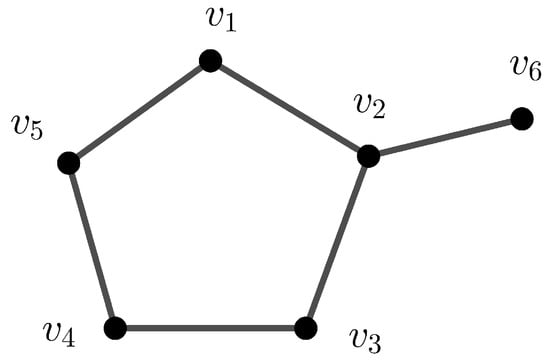
Figure 2.
The cycle with one pendant edge .
Theorem 2
([14]).Let be a positive integer.
- 1 .
- If G is -magic, then G is -free.
- 2 .
- If G is -magic, then G is -free.
In [14,15], Maryati et al. provided another forbidden subgraph of path-magic graphs by defining an graph. The graph is a graph with and (Figure 3 illustrates the graph ).

Figure 3.
The graph .
Theorem 3
([14,15]).Let be a positive integer. If G is -magic, then G is -free.
In [12], Gutiérrez and A. Lladó also established some necessary conditions of star-magic graphs by considering the degree of vertices.
Theorem 4
([12]).Let f be a -magic labeling of a graph G with magic constant . If the degree of vertex verifies , then for every vertex y adjacent to x, we have .
Corollary 1
([12]).Let G be a -magic graph with . Then, for every edge of G, .
In the following theorems, we present some known classes of cycle-supermagic graphs, a more complete list can be found in [7]. We recall the definition of the graphs mentioned in the theorems. A fan is a graph obtained from connecting a single vertex to all vertices in cycle . A wheel is a graph with vertices obtained from connecting a single vertex to all vertices in cycle . For , a windmill is a graph obtained by identifying one vertex in each of the k disjoint copies of the cycle . For , a ladder , is defined as , whose vertex set is and and edge set is and . Illustrations of a wheel, a fan, and a ladder can be seen in Figure 4.
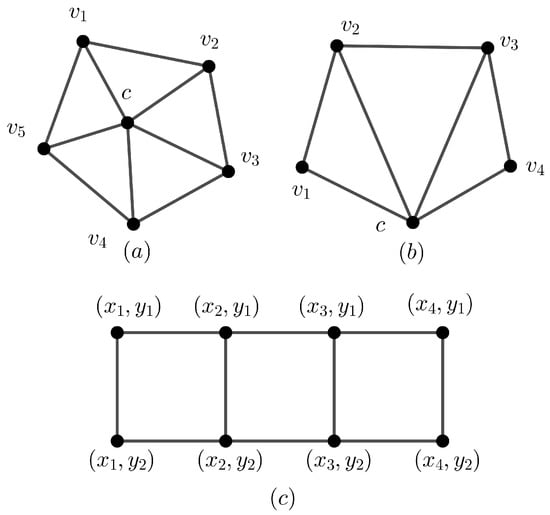
Figure 4.
(a) The wheel , (b) the fan , and (c) the ladder .
Theorem 5
([16,17]).For , the wheel is -supermagic.
Theorem 6
([16]).For any two integers and , the windmill is -supermagic.
Theorem 7
([18]).Let be a positive integer.
- 1 .
- The fan is -supermagic for any integer ;
- 2 .
- The ladder is -supermagic for any positive integer .
One important observation on H-magicness is the following.
Observation 1.
If G is H-magic then is also H-magic.
The converse of Observation 1 is not true. For example, is -supermagic (as shown in Figure 5) but is not -magic (as a result of Theorem 1 in [14]).
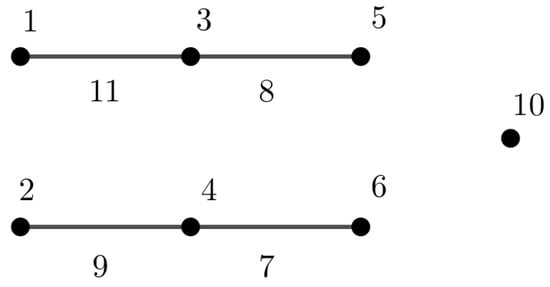
Figure 5.
-magic of .
Due to this fact, in the rest of the paper, we restrict our observation to graphs with components not isomorphic to .
3. -Sim-Supermagic Labelings
In this section, we provide the collection of forbidden subgraphs and characterize a -sim-supermagic graph.
Let and be two integers. We denote the edge sets of a path and a cycle as and , respectively. An -tadpole is a graph obtained by joining the end vertex of to the vertex of . Figure 6 shows the -tadpole graph.

Figure 6.
The -tadpole graph.
We denote the star with n pendant edges as . Consider the star with three pendant edges denoted by . We define as a subdivision of the star by replacing the edge with a path on n vertices and the remaining edges by paths on three vertices. Figure 7 illustrates the subdivided star .
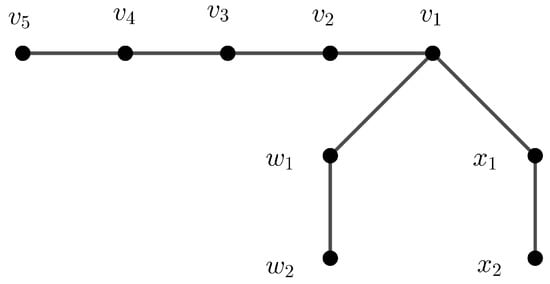
Figure 7.
The graph.
In [19], Maryati et al. introduced a subgraph-amalgamation. For , let be a collection of graphs s where each contains as a fixed subgraph and let be the collection of s. The H-amalgamation of , denoted by , is a graph constructed from identifying the of each . If is isomorphic to a given graph G, we write the H-amalgamation as .
Let be an -tadpole containing a subgraph isomorphic to ; let be a path , whose edge set is , containing a subgraph isomorphic to ; and . Figure 8 illustrates the -tadpole,.
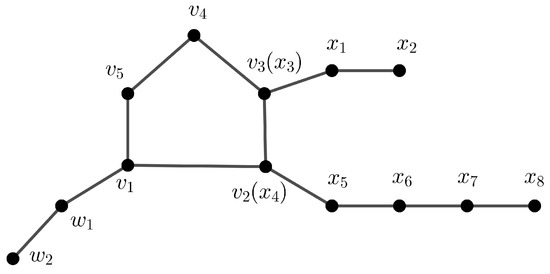
Figure 8.
The -tadpole, graph.
The next theorem stated forbidden subgraphs of -sim-(super)magic graphs.
Theorem 8.
If G is -sim-(super)magic, then G is H-free where
- 1 .
- , for any and ;
- 2 .
- , for any ;
- 3 .
- , for any ;
- 4 .
- , for any ;
- 5 .
- -tadpole, for any and ;
- 6 .
- -tadpole, , for any and .
Proof.
The case where , for any and , is an immediate consequence of Theorems 1 and 2; and the case where , for any , is an immediate consequence of Theorem 3. The rest of the cases are proven as follows.
Case 3. , for any .
Suppose that G is a -sim-(super)magic graph and G is not -free. Let f be a -sim-(super)magic labeling of G. Consider two subgraphs isomorphic to with edges and . Since G is -magic,
By eliminating in both sides of Equation (1), we have
However, . This clearly forces , a contradiction.
Case 4. , for any .
Assume to the contrary that G is -sim-(super)magic and G contains as a subgraph. Let f be a -sim-(super)magic labeling of G. Consider a subgraph H isomorphic to . Label the vertex set and the edge set . There exist two paths isomorphic to with edges and . As f is a -sim-(super)magic labeling, we have Thus, we obtain , a contradiction.
Case 5. -tadpole, for any and .
Suppose that G is -sim-(super)magic and contains -tadpole as a subgraph. Let f be a -sim-(super)magic labeling of G. Next, let k be an arbitrary positive integer with . Consider a subgraph H isomorphic to -tadpole. Denote the vertex set and the edge set . Consider two paths isomorphic to with edges and . Since G is -sim-(super)magic, . As a result, we have , a contradiction.
Case 6. -(tadpole), , for any and .
Assume to the contrary that G is -sim-(super)magic and contains a subgraph isomorphic to -(tadpole), . Let f be a -sim-(super)magic labeling of G. Then, let m be an arbitrary positive integer with . Consider a subgraph H of G isomorphic to -(tadpole), . Denote the vertex set and the edge set . Consider two paths isomorphic to with edges and . As G is -sim-(super)magic, we have
. Thus, we have , a contradiction. □
We remark that if G is -sim-(super)magic, then is the longest path of G. Notice that, for , contains as a subgraph. By Theorem 8, such graphs are not -sim-supermagic. The converse of Theorem 8 is not true as shown in the following example.
Example 1.
The graph is not -sim-(super)magic for any integer .
Proof.
Suppose that there exists a -sim-(super)magic labeling on . Let be the set of the internal vertex label in a for . Clearly . For each edge , the -weight, . Thus, the -weight of is for every . Consequently, should be a constant for every , a contradiction. □
Problem 1.
What are the other forbidden subgraphs of -sim-(super)magic graph?
As a consequence of Theorem 8 where , for any integer , we have the following two results.
Corollary 2.
Let be a positive integer and G be a graph that admits -covering. If G is -sim-(super)magic, then .
Corollary 3.
Let be a positive integer and G be a graph that admits -covering. If G is -sim-(super)magic, then G is -free for any .
By the previous two corollaries, Theorem 8, and Example 1, we have the following corollaries.
Corollary 4.
Let and G be a graph that admits -covering. If G is -sim-(super)magic, then G is a forest. In particular, if G is -sim-(super)magic, then G is a tree.
Let be a positive integer. In [12], it is proved that the star is -supermagic for each . Moreover, the -supermagic labeling of in [12] is also an SEMT labeling of . Combining with Example 1 and Corollary 4, we obtain the following.
Corollary 5.
A graph G is -sim-(super)magic if and only if G is isomorphic to the star for any positive integer .
A caterpillar is a graph derived from a path , , where the vertex is adjacent to leaves, . A special case of caterpillars when , , and is called a double star . An illustration of the double star and a -sim-supermagic labeling on can be seen in Figure 9. Since Kotzig and Rosa [1] have proved that all caterpillars are SEMT, utilizing Corollary 4, we have the following.
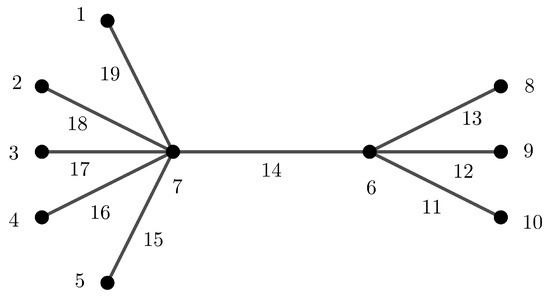
Figure 9.
A -sim-supermagic labeling of the double star .
Corollary 6.
A connected graph G is -sim-(super)magic if and only if G is isomorphic to a double star for any two positive integers m and n.
Problem 2.
Characterize -sim-(super)magic graphs for any .
We conclude this section by presenting sufficient conditions for an (S)EMT graph to be -sim-(super)magic.
Lemma 3.
Let k and n be two positive integers. Let G be a graph of order at least that admits -covering. Let be the family of all subgraphs of G isomorphic to and let be the sum of all internal vertices labels in for every . If f is an (S)EMT labeling in G such that is constant, for each , then G is -sim-(super)magic.
Proof.
Let be the magic sum of the labeling. Let be two positive integers in . Consider two arbitrary paths and in . Thus, . Hence, we have the following:
As a result, the sum of all edges and vertices labels associated to a subgraph of G isomorphic to is a constant. Therefore, G is a -(super)magic. Since f is simultaneously SEMT and -(super)magic, G is -sim-(super)magic. □
As an immediate consequence of Lemma 3, we have the following special cases of caterpillars that are -sim-magic. The broom is defined as a graph isomorphic to the caterpillar where and . The double broom is a graph isomorphic to the caterpillar where , , and . Figure 10 illustrates the broom and the double broom .
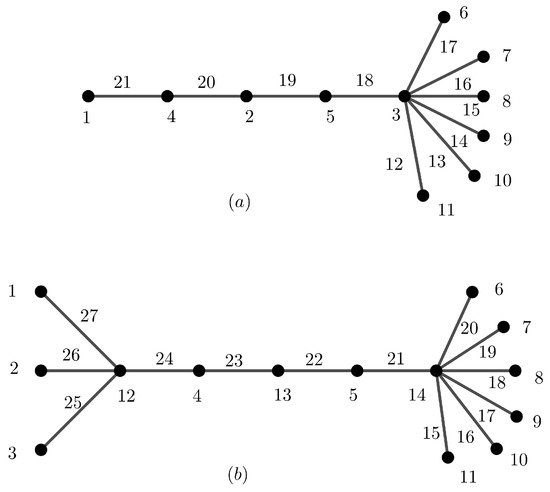
Figure 10.
(a) A -sim-supermagic labeling of the broom and (b) A -sim-supermagic labeling of the double broom .
Corollary 7.
Let and m be three positive integers at least two and . The broom and the double broom are -sim-magic.
Proof.
It is known that all caterpillars are edge magic [1]. Moreover, all subgraphs isomorphic to have the same internal vertices. This completes the proof. □
Figure 10 illustrates -sim-supermagic labelings of the broom and the double broom for and , respectively.
4. A -Sim-Supermagic Labelings
In this section, we characterize -sim-(super)magic graphs. Clearly, necessary conditions of -magic graphs in Theorem 4 and Corollary 1 are also necessary conditions of -sim-(super)magic graphs. In the following Lemma, we strengthen the degree condition of Corollary 1 for -sim-(super)magic graphs.
Lemma 4.
Let be a positive integer and G be a -sim-(super)magic. Then, there is only one vertex x of G with .
Proof.
Suppose that there are two vertices v and w in such that and . Let f be a -sim-(super)magic labeling of G. Hence, there exist two positive integers and such that each edge satisfies and each subgraph H of G isomorphic to satisfies . Consider two arbitrary stars with center v and w that are isomorphic to as and . Thus,
As a result, we have , a contradiction. □
Recall that Gutiérrez and Lladó [12] proved the following theorem. The labeling in the proof of the theorem will be utilized to characterize -sim-supermagic graphs.
Theorem 9
( [12]). The star is -supermagic for any .
Proof.
Denote the vertex set of by , where is the maximum degree vertex, and the edge set of by . Define a bijection with and , for any , and . Thus, . We can verify that (constant) for every subgraph H of isomorphic to . Therefore, is -supermagic for each . □
Now we are ready to characterize -sim-supermagic graphs.
Theorem 10.
Let be a positive integer. A graph G is -sim-supermagic if and only if G is isomorphic to the star for .
Proof.
(⇐) First, we prove that, for , the star is -sim-supermagic. Recall the -supermagic labeling of in the proof of Theorem 9, where (constant), for each edge in . Hence, is -sim-supermagic for .
Conversely, we prove that if G is -sim-supermagic, then G is isomorphic to the star for . Clearly, a connected graph G with order two and three is isomorphic to and , respectively. Then, consider G with order at least four. Suppose to the contrary that G is not isomorphic to any star . Let e be an arbitrary edge in G. Suppose that e belongs to , a subgraph isomorphic to , where e is incident with c, the center of . Since G is not isomorphic to a star, there exists another edge which is not incident with c. Since G admits -covering, then belongs to a subgraph that is isomorphic to where the center is not c, a contradiction by Lemma 4. □
We remark that by considering , we can derive another proof of Corollary 5 from Theorem 10.
5. A -Sim-Supermagic Labelings
In this section, we list some forbidden subgraphs and some -sim-(super)magic graphs. We start by presenting results for -sim-(super)magic graphs of order n by considering the relation between two well-known magic labelings: (S)EMT and -(super)magic.
Lemma 5.
Let G be a graph of order n admitting a covering. If G is (S)EMT then G is -(super)magic.
Proof.
Let f be an EMT labeling of G. Thus, there exists a positive integer such that for each edge in . Denote as the set of vertices in G. Define a bijection with for all V(G). Consider an arbitrary subgraph C isomorphic to . Since the label of each vertex x is counted twice in , then , a constant. Therefore, G is -(super)magic. □
The converse of Lemma 5 is not true since is -(super)magic, although it is known that is neither EMT [1,3] nor SEMT [3] (See Figure 11). However, it is clear that we have the following necessary and sufficient condition for a graph of order n to admit a -sim-(super)magic labeling.

Figure 11.
(a) A -supermagic labeling of and (b) A -magic labeling of .
Corollary 8.
Let G be a graph order n admitting a covering. G is (S)EMT if and only if G is -sim-(super)magic.
It is known that the complete graph is EMT if and only if [1]. Since each pair of vertices in are adjacent, the number of subgraphs of isomorphic to is the number of n-cycles in the symmetric group , which is Thus, the number of subgraphs of and isomorphic to and is 24 and 120, respectively.
Corollary 9.
Let be a positive integer. A complete graph is -sim-magic if and only if or .
Proof.
(⇐) Recall the known EMT labeling f in for or 6 [1]. By Lemma 5, f is a -magic labeling. This gives as -sim-magic for or 6.
(⇒) Conversely, it is immediately known from the fact that is not EMT according to Kotzig and Rosa [1]. □
Figure 12 shows -sim-supermagic and -sim-supermagic graphs.
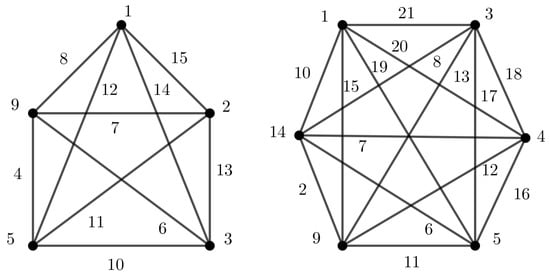
Figure 12.
A -sim-supermagic labeling for .
Kotzig and Rosa [1] proved that the complete bipartite graph is EMT for all m and n. Philips et al. [20] constructed an EMT labeling of the wheel for or 2(mod 4). By Lemma 5, we have the following Corollary.
Corollary 10.
Let be a positive integer.
- 1 .
- is -sim-magic;
- 2 .
- is -sim-magic for or 2(mod 4).
In the next two theorems, we consider a -sim-supermagic labeling of a cycle with chords. A chord is an edge joining two non-adjacent vertices in a cycle. An n-power of graph is a graph with the vertex set and any two vertices are adjacent when their distance in G is at most n. Recall from Lemma 2 that is not SEMT, so it is if we remove at most two edges from . Thus, it is interesting to construct a maximal SEMT graph, where the number of edges is equal to the upper bound of inequality in Lemma 2, from .
Let be a positive integer and be the vertex set of the cycle . Let be the set of three edges in . We define the cycle with chords where the vertex set is and the edge set is . It is clear that admits a -covering for every odd integer and we have the following theorem.
Theorem 11.
Let be an odd integer. A cycle with chords is -sim-supermagic.
Proof.
Let be the vertex set of . Define a bijection as , for . Thus, for each edge , we have
- 1 .
- , for each ;
- 2 .
- ;
- 3 .
- , for and .
Consequently, and the set consists of consecutive integers. By Lemma 1, is SEMT and f is the SEMT labeling with magic sum . By Lemma 5, f is also a -supermagic labeling of . This concludes that is -sim-supermagic. □
Figure 13a illustrates a -sim-supermagic labeling of .
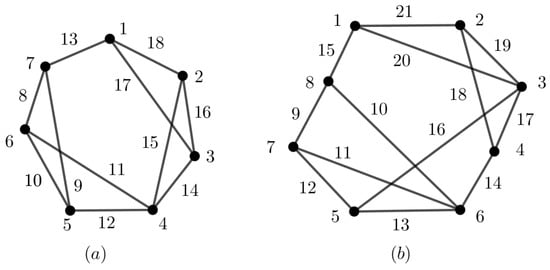
Figure 13.
(a) A -sim-supermagic labeling and (b) A -sim-supermagic labeling of .
Let be an even integer. Let . We define the cycle with chords as a graph where the vertex set is and the edge set is . Such a cycle with chords admits -covering for each an even integer.
Theorem 12.
Let be an even integer. A cycle with chords is -sim-supermagic.
Proof.
Let be the vertex set of . Define a bijection as follows.
- , for every and ;
- ;
- .
For each , we have
- , for each and ;
- ;
- ;
- , for each , and ;
- ;
- ;
- .
It can be counted that and the set consists of consecutive integers. By Lemma 1, is SEMT and f is the SEMT labeling with magic sum . By Lemma 5, f is also a -supermagic labeling of . This concludes that is -sim-supermagic. □
Figure 13b shows a -sim-supermagic labeling of cycle with chords .
In addition to maximal SEMT graphs construction, we remark that Theorems 11 and 12 also enlarge the classes of graphs known to be -supermagic and SEMT.
Notice that up to Theorem 12 we only consider -sim-supermagic graphs of order n. Therefore, it is interesting to ask whether an (S)EMT graph G of order n can admit a -(super)magic labeling, for . We start by presenting some forbidden subgraphs of -sim-(super)magic graphs, for .
Theorem 13.
If G is -sim-(super)magic, then G is H-free, where
- 1 .
- , for any ;
- 2 .
- , for any .
Proof.
Suppose that G is -sim-(super)magic and G is not H-free. Then, G contains a subgraph that is isomorphic to H. Let f be a -sim-(super)magic labeling of G, such that there exist two positive integers and , satisfying and , for each edge and for each subgraph C isomorphic to , respectively. We consider the following two cases.
Case 1. .
Consider a subgraph of a graph G. Denote the vertices in by such that the edge set is . There are two cycles and isomorphic to with and . Then,
or
Since for each edge , . Hence, , a contradiction.
Case 2. .
Consider a subgraph of a graph G. Denote the vertices in by such that the edge set is . There are two cycles and isomorphic to with and . Then
or
Thus and . Hence, , a contradiction. □
The converse of Theorem 13 is not true. Consider m copies of isomorphic cycles of order n, . It is clear that admits -covering and is H-free, for H isomorphic to the forbidden subgraphs in Theorem 13. However is SEMT if and only if m and n are odd [21], and so , for even , is not -sim-supermagic. Therefore, the two subgraphs in Theorem 13 are not the only forbidden subgraphs of -sim-supermagic graphs.
Problem 3.
What are the other forbidden subgraphs of -sim-(super)magic graphs?
In the following lemma, we state sufficient conditions for an (S)EMT graph to be a -sim-(super)magic graph.
Lemma 6.
Let and be two positive integers. Let G be a graph order at least that admits -covering. Let be the family of all subgraph of G isomorphic to and be the sum of all vertices labels in , for each . If f is an (S)EMT labeling in G such that is constant, for every , then G is -sim-(super)magic.
Proof.
Let as the magic sum of the labeling. Let be two positive integers in . Consider two arbitrary cycles and in . Thus, . Hence, we have that
Hence, the sum of all edges and vertices labels associated to a subgraph of G isomorphic to is a constant. Therefore, G is a -(super)magic for each . Since f is simultaneously an (S)EMT and -(super)magic, G is -sim-(super)magic. □
Consequently, by Lemma 6, we have the following corollary.
Corollary 11.
Let be an odd integer. The disjoint copies of cycle on 3 vertices, , is -sim-supermagic.
Proof.
Recall an SEMT labeling of , for odd m, from [21]. We denote and and and and define
Let be a subgraph of isomorphic to and be the sum of all vertices labels in . Hence, for , we have
and, for , we have
Therefore, is constant for . By Lemma 6, is -sim-supermagic. □
6. Open Problems
We conclude by listing open problems from the previous sections that could be interesting for further investigation.
- What are the other forbidden subgraphs of -sim-(super)magic graph?
- What are the other forbidden subgraphs of -sim-(super)magic graphs?
- Characterize -sim-(super)magic graphs for any .
Author Contributions
Conceptualization, Y.F.A., A.N.M.S. and R.S.; methodology, Y.F.A. and R.S.; formal analysis, Y.F.A., R.S. and A.N.M.S.; writing—original draft preparation, Y.F.A. and R.S.; writing—review and editing, Y.F.A., A.N.M.S. and R.S.; supervision, A.N.M.S. and R.S.; funding acquisition, Y.F.A., A.N.M.S. and R.S. All authors contributed equally to this work. All authors have read and agreed to the published version of the manuscript.
Funding
Y.F.A. and A.N.M.S. were funded by PMDSU Scholarship, Directorate General of Higher Education, Ministry of Education and Culture of Indonesia; R.S. was partially funded by Penelitian Dasar 2018–2021 (Indonesian National Research and Innovation Agency), Grant Number 2/E1/KP.PTNBH/2021.
Data Availability Statement
Not applicable.
Conflicts of Interest
The authors declare no conflict of interest.
Abbreviations
The following abbreviations are used in this manuscript:
| SEMT | Super edge magic total |
| EMT | Edge magic total |
References
- Kotzig, A.; Rosa, A. Magic valuations of finite graphs. Can. Math. Bull. 1970, 13, 451–461. [Google Scholar] [CrossRef]
- Ringel, G.; Lladó, A. Another tree conjecture. Bull. Inst. Combin. Appl. 1996, 18, 83–85. [Google Scholar]
- Enomoto, H.; Lladó, A.; Nakamigawa, T.; Ringel, G. Super edge-magic graphs. SUT J. Math. 1998, 34, 105–109. [Google Scholar]
- Figueroa-Centeno, R.M.; Ichishima, R.; Muntaner-Batle, F.A. The place of super edge magic labelings among other classes of labelings. Discret. Math. 2001, 231, 153–168. [Google Scholar] [CrossRef]
- Bača, M.; Lin, Y.; Miller, M.; Simanjuntak, R. New constructions of magic and antimagic graph labelings. Util. Math. 2001, 60, 229–239. [Google Scholar]
- Bača, M.; Miller, M.; Ryan, J.; Semaničová-Feňovčíková, A. Magic and Antimagic Graphs: Attributes, Observations, and Challenges in Graph Labelings; Springer International Publishing: Cham, Switzerland, 2019. [Google Scholar]
- Gallian, J.A. A dynamic survey of graph labeling. Electron. J. Combin. 2020, 23, DS6. [Google Scholar]
- López, S.C.; Muntaner-Batle, F.A. Graceful, Harmonious, and Magic Type Labelings: Relations and Techniques; Springer: Cham, Switzerland, 2017. [Google Scholar]
- Marr, A.M.; Wallis, W.D. Magic Graphs; Birkäuser Basel: Berlin, Germany, 2013. [Google Scholar]
- Macdougall, J.A.; Wallis, W.D. Strong edge-magic graphs of maximum size. Discret. Math. 2008, 308, 2756–2763. [Google Scholar] [CrossRef][Green Version]
- Sugeng, K.A.; Xie, W. Construction of super edge magic total graphs. In Proceedings of the Sixteenth Australasian Workshop on Combinatorial Algorithms 2005, Ballarat, Australia, 18–21 September 2005; pp. 303–310. [Google Scholar]
- Gutiérrez, A.; Lladó, A. Magic coverings. J. Combin. Math. Combin. Comput. 2005, 55, 43–56. [Google Scholar]
- Ashari, Y.F.; Salman, A.N.M.; Simanjuntak, R.; Semaničová-Feňovčíková, A.; Bača, M. On (F, H)-simultaneously-magic labeling of graphs. 2021; Submitted. [Google Scholar]
- Maryati, T.K.; Baskoro, E.T.; Salman, A.N.M.; Irawati. On the path-(super)magicness of a cycle with some pendants. Util. Math. 2015, 96, 319–330. [Google Scholar]
- Maryati, T.K.; Baskoro, E.T.; Salman, A.N.M. Ph-(super)magic labelings of some trees. J. Combin. Math. Combin. Comput. 2008, 65, 197–204. [Google Scholar]
- Lladó, A.; Moragas, J. Cycle-magic graphs. Discret. Math. 2007, 307, 2925–2933. [Google Scholar] [CrossRef][Green Version]
- Roswitha, M.; Baskoro, E.T.; Maryati, T.K.; Kurdhi, N.A.; Susanti, I. Further results on cycle-supermagic labeling. AKCE Int. J. Graphs Comb. 2013, 10, 211–220. [Google Scholar]
- Ngurah, A.A.G.; Salman, A.N.M.; Sudarsana, I.W. On supermagic coverings of fans and ladders. SUT J. Math. 2010, 46, 67–78. [Google Scholar]
- Maryati, T.K.; Salman, A.N.M.; Baskoro, E.T. Supermagic coverings of the disjoint union of graphs and amalgamations. Discret. Math. 2013, 313, 397–405. [Google Scholar] [CrossRef]
- Philips, N.C.K.; Rees, R.S.; Wallis, W.D. Edge-magic total labelings of wheels. Bull. Inst. Combin. Appl. 2001, 31, 21–30. [Google Scholar]
- Figueroa-Centeno, R.M.; Ichishima, R.; Muntaner-Batle, F.A. On super edge-magic graphs. Ars Combin. 2002, 64, 81–95. [Google Scholar]
Publisher’s Note: MDPI stays neutral with regard to jurisdictional claims in published maps and institutional affiliations. |
© 2021 by the authors. Licensee MDPI, Basel, Switzerland. This article is an open access article distributed under the terms and conditions of the Creative Commons Attribution (CC BY) license (https://creativecommons.org/licenses/by/4.0/).